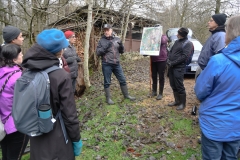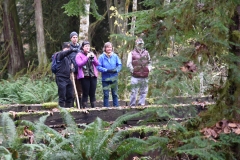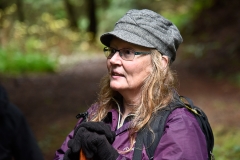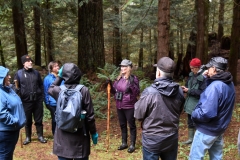
Morrison Creek Streamkeepers President Jan Gemmell tells her latest tour group about the property owner’s, the late Beecher Linton, favorite spot. Gallery below. George Le Masurier photo
Morrison Creek headwaters are unique on Vancouver Island
Jim Palmer and Jan Gemmell, along with David Stapley, guided nearly a dozen people Nov. 24 through the first, small portion of the Morrison Creek headwaters that the Comox Valley Lands Trust intends to purchase and preserve.
The tour was the latest of many that the Morrison Creek Stream Keepers have conducted on the 55 acre property owned by the late Beecher Linton since the 1960s, located to the south of Lake Trail Road and just north of the Inland Highway.
The Lands Trust identified the Morrison headwaters among the top three properties in the Comox Valley to acquire and conserve because of its high biodiversity values and its crucial role in sustaining water quality and quantity in the rest of the watershed. Other streams and creeks near the urbanized areas of the Valley have been developed to various degrees, compromising their ability to support robust fish and wildlife populations and sustain stream flow and water quality.
“It’s highly unusual to have have an intact headwaters on Vancouver Island,” Jim Palmer said. “And even more odd that it’s entirely spring-fed.”
The springs are seepage from the deep groundwater flows of Comox and Maple lakes that become a multitude of open tributaries at the base of an escarpment just below Bevan Road. Together, they become Morrison Creek, which empties into the Puntledge River.
“It’s a wilderness oasis unaffected by human disturbances”
Stapley told the tour group that about 88 percent of $870,000 acquisition cost for the Linton property has been raised. But the CVLT wants to acquire and conserve the entire watershed, which measures about 600 acres and is owned by the Hancock Timber Resource Group. The whole watershed is roughly the size of Vancouver’s Stanley Park.
A 24-acre parcel of the watershed has already been preserved by the BC Government and known as the Beecher Linton Conservation Area.
Jim Palmer, currently vice-president of the Morrison Creek Stream Keepers and a member for more than 20 years, said the 55-acre Linton site not only includes some of the many tributaries that comprise Morrison Creek, but it’s also the location of the historical Leung family farm. During the early 1900s, the Leungs supplied the main agricultural products that sustained the early settlers of Cumberland and Courtenay.
It’s also the site of the Gwilt logging company that operated a sawmill on the property, which burned down in the early 1920s, and the China Trail, a wagon road that linked the Leung farm with the growing communities.
Palmer, Gemmell and Stapley pointed out numerous coho salmon making their way up the creek, a long journey from the Strait of Georgia and the Puntledge River and turning up Morrison just below the Puntledge rapids. The headwaters regularly has coho and pink salmon, while chum and trout stay in its lower reaches.
FURTHER INFORMATION: To support the Morrison Creek acquisition and additional information, click here
Jan Gemmell, president of the Morrison Creek Stream Keepers, pointed out that the creek is also home to the Morrison Creek lamprey, a unique variation of the common Western Brook Lamprey found on the coast. It is only found in Morrison Creek. It is distinguished by being polymorphic, meaning both parasitic and non-parasitic. Male Morrison lampreys make their nests by carry pebbles in their mouths, one at a time, and shaking their bodies to create indentation in the stream bed.
Because the creek is completely natural, Palmer said it looks “untidy,” with logs and rocks strewn about that have created miniature dams and reservoirs. But Palmer said these unruly natural formations actually play a major role in the creek’s health.
As the stream carries sediment down, gravel builds up behind the log jams while deep pools are created by cascading water in front of them. Both serve a function for fish to navigate up stream.
Different fish prefer different types of stream beds, from coarse to fine. And the interplay between the type of stream bed and the current determines the speed of the water at any given time, creating a variety of micro-habitats. And the wood in the water indirectly serves as a breeding ground for aquatic invertebrates, the flies that fish love to feast on.
The importance of the whole Morrison headwaters extends beyond the creek itself and its tributaries. It’s a vast, bio-diverse and thriving ecosystem of swamps, marshes and beaver ponds. “It’s a wilderness oasis unaffected by human disturbances,” Palmer said.
The Comox Valley Lands Trust has until March 31 or next year to raise the final $100,000.
“But don’t let that stop you from donating right now,” Stapley said, because the Lands Trust needs to have additional funds to launch the coming campaign to protect the entire Morrison Creek watershed.
Morrison Creek Stream Keepers have taken more than 130 people on tours of the Morrison Creek headwaters in groups ranging from one to a dozen. At times they have taken three tours in a single week. The longest lasting tour took five hours and covered most of the property.
On Merville groundwater extraction it’s deja vu all over again
Regional district staff recommend approving an amended application for groundwater extraction in Merville as a “home occupation,” but rural area directors want more clarity on its legal definition
Merville water bottling issue returns to the CVRD, highlights provincial water policies
The Comox Valley Electoral Areas Service Commission will consider on Monday an amended application for water bottling operations in Merville and draw attention to larger water policy issues in British Columbia
What’s dire: the lack of Comox subdivisions or climate change and gradual deforestation?
A Comox Valley developer is suing the Town of Comox because his permits to cut down trees and build more single-family homes haven’t been issued as fast as he’s wanted and because the town wants a wider walking trail through the property
Courtenay Council announces its regional district line-up and other appointments
Courtenay City Council’s annual appointments announced after a short delay
A few random items as the 2022 election comes to a close
Long-time public official Bronco Moncrief dies, Manno Theos hangs out in Greece, and Daniel Arbour reacts to lies about his campaign finances
Decafnation candidate voting sheet
A list of candidates endorsed by Decafnation
Join the discussion Oct. 3 about food system security in the Comox Valley
The Watershed Sentinel magazine is hosting a zoom webinar Oct. 3 on food system security in the Comox Valley
THE WEEK: Busting the myth that council members come with a blank slate
The Old Guard faction of Comox Valley political activists has been trying for decades to create a cohesive voting block
Three candidate forums for Oct. 15 Comox Valley elections
See and hear the candidates in person for this fall’s municipal elections. We list the three candidate forums
The Mack Laing Trust: BC Supreme Court hears arguments in 40-year case
Mack Laing Heritage Society says the Town of Comox is in a rush to clean up a mess of its own making, while town and Attorney General lawyers call The Society’s evidence “irrelevant.”







Thanks for the great article about this important wildlife habitat and the value in protecting it.